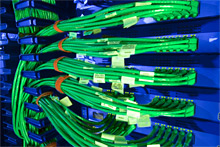Computing
Networking
Physicists are constantly exchanging information, within Fermilab and between Fermilab and collaborating institutions. They do this from the design phase of an experiment to long after they have finished collecting data. To move huge amounts of data from one place to another, Fermilab needs high-performance networking.
For years, Fermilab has been the largest user of Energy Services Network, or ESnet, a network the Department of Energy runs through Lawrence Berkeley National Laboratory to help national laboratories share data.
Networking systems must be in top shape when moving large amounts of data across the nation and overseas. Whenever data moves a long distance, defects in a networking system are magnified. Small glitches that physicists transferring data to one another within the same laboratory would never notice can be disastrous for cross-country transfers of large amounts of data.
To send large amounts of data long distances, physicists need to set up special high-capacity paths. Just as regular cars cannot use high-occupancy vehicle lanes on the highway, other data cannot use these dedicated paths to move from place to place.
Within Fermilab, users can transfer data at a rate of 8 gigabytes per second. That is equivalent to transferring an entire film on Blu-ray DVD every couple of seconds. By setting up dedicated pathways on which to transfer data to and from locations outside of the laboratory, Fermilab allows users to transfer data off-site at a rate of 10 gigabytes per second.
But securing use of a dedicated circuit can be expensive. That is why Fermilab’s Lambda Station Project allows scientists to rent part-time use of a dedicated path.
- Last modified
- 03/19/2015
- email Fermilab


